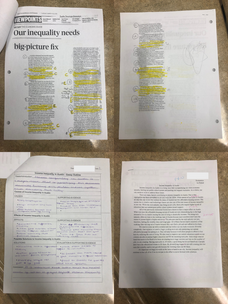Field Experience
Crockett High School - 12th Grade Economics
For my field experience I was given the opportunity to work with Mrs. Crystal Fox teaching Economics to High School seniors. It was a please to learn from her 20 years of experience as we worked together in her classroom. I spend 70 hours in her classroom teaching 6 different lessons throughout the semester, with a total of 9 teaching days.
Lessons
12th Grade Economics
Click the folder to view the lesson plans.
Free Trade
Students will be introduced to the benefits and costs of free trade. They will have class discussion, read an article using a jigsaw activity, collect information from a video and article for a class debate. By the end of class, they will be able to explain the constant and beefits of free trade and develop their own conclusions.
Free Trade
Students will be introduced to the benefits and costs of free trade. They will have class discussion, read an article using a jigsaw activity, collect information from a video and article for a class debate. By the end of class, they will be able to explain the constant and beefits of free trade and develop their own conclusions.
Lesson Highlight
Why learn about free trade?
Think about your morning routine. You get out of bed, get dressed, eat breakfast, check your phone, drink coffee, and drive to work. Each of these actions involves goods that came from somewhere else.
Understanding the costs and benefits to free trade will help students become conscious consumers. Free trade can make goods people want cheaper, but it can also come at a cost to certain industries in a country. Additionally, free trade is a prominent issue in today's politics. Most recently the US President has threatened a trade war with China due to the inability to come to a trade agreement. Learning about free trade helps students understand a current political issue that impacts goods and jobs, as well as making them more conscious as consumers of where their products come from.
Additionally, this lesson includes strategies for discussion, reading, organizing to help students develop skills in these areas. The lesson starts with a Think, Pair Share discussion to get the students thinking and talking about where their products come from. A Jigsaw strategy is used to help students read & break down an article on globalization. Students organize the information into a debate format before haveing a class debate on free trade.




Austin's Income Inequality
The lesson will begin by recalling student’s prior knowledge of income inequality and have them find examples from their community. Then they will read an article from local newspaper, Austin American-Statesman, using an AVID critical reading strategy. Students will then use the reading to fill out a pre-write organizer to prepare for writing a three-paragraph essay on the causes, effects, and potential solutions for Austin’s income inequality.
Business Organizations I
Students will learn about the different forms of business organizations (aka legal structures), including sole proprietorship, partnership, and corporations. They will start by imagining what they would need to start a business of their own. Then they will watch a series of videos and participate in class discussion to collect notes on the characteristics, advantages, and disadvantages in their graphic organizer. Students will show their understanding of the content by creating visualizations of the three main forms business organization and write one paragraph on which form they would use to start their own business with a justification.
Business Organizations I
In this lesson, students will Jigsaw an article to gather information on the different forms of business organizations (aka legal structures) - including sole proprietorship, partnership, and corporations – and on their characteristics, advantages, and disadvantages in their graphic organizer. Students will demonstrate understanding of this information through the “Sweet Opportunities” by giving a one-paragraph recommendation for clients.
Student Work Gallery
Click on the images to see descriptions
Video
From Lesson #1: Supply
The goal of the engage activity was for the students to connect the determinants of supply to their cell phones. The warm-up question was geared to have students explain how the determinants of supply, learned the class before, would impact the smartphone market. Many students had initially confused the determinants of supply and demand, but we were able to correct this through discussion. Then they were able to make the connections to the supply determinants, instead of those for demand. This change was evidence that they had managed to shift their perspective from supply to demand.
From watching myself, I could tell I was a little nervous. I was unsure how the students would react to me being in charge of the classroom and concerned they might ask something outside of my knowledge. Therefore, it’s reasonable that I would be nervous in my first minutes in charge. One strength I saw was keeping wait-time and reminding students to stay on task. I did my best to give students an ample amount of time to do the task while providing reminders of how long they had left. I also moved around the classroom, using proximity to ensure students were not feeling stuck or getting distracted while gauging student level of task completion. Throughout the semester I improved in my confidence in being in front of the class as I got to know my students better,






